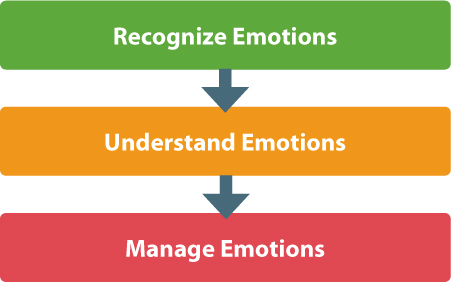Build Emotional Intelligence
Emotional intelligence — the ability to recognize, understand, and manage your own and others’ emotions — is a critical part of communicating and connecting effectively with others (see Figure 11.2).2 It can also help you learn about yourself and better manage how you respond to others. Thus emotional intelligence is both interpersonal (between people) and intrapersonal (within ourselves).

Emotional Intelligence: The ability to recognize, understand, and manage your own and others’ emotions.
To see how emotional intelligence works, let’s say your friend Gustavo just broke up with his significant other. He’s weeping as he tells you about the breakup, so you recognize that he’s sad, and you might seek to understand the reason for his sadness by saying, “Did you think things were going better than they really were?” You might then try to help Gustavo manage his sadness by offering a sensitive response: “I’m so sorry, Gustavo. That must be hard. Is there anything I can do to help?”
FURTHER READING: For more information on the importance of emotional intelligence, read Travis Bradberry’s 2015 article “Why You Need Emotional Intelligence to Succeed” (on Forbes.com).
And during conversations, recognizing, understanding, and managing your own emotions can also help you communicate more effectively. For example, suppose a coworker tells you excitedly that she just received the employee of the month award. You always arrive for work early and talk enthusiastically with customers, so you feel strongly that you deserve the award more than your coworker, who spends all day on her phone and takes too many breaks. You recognize that you feel unappreciated, and thanks to this understanding, you can rein in your emotional reaction and respond appropriately. Instead of shouting, “You don’t deserve that award!” you can manage your emotions and politely congratulate your coworker. Later, you can look up the criteria for the award and schedule a meeting with your boss to discuss his perceptions of your work performance.
Let’s take a closer look at how you can handle situations like these in healthy ways by mastering the three key elements of emotional intelligence.
Recognize Emotions
The first step in exercising emotional intelligence is recognizing emotions — identifying what you or another person is feeling and labeling it.3 Is it sadness? Excitement? Anger? Embarrassment? Joy?
CONNECT
TO MY EXPERIENCE
Select a strong feeling you’ve had today (good or bad) and rate the intensity of this feeling on a scale of 1 (low intensity) to 10 (high intensity). As you reflect on this feeling, record your reactions. What thoughts or words do you associate with this emotion? What physical reactions?
Your Emotions. To better recognize your own emotions, there are a number of strategies you can try, including the following:
Find and use words that designate emotions. Google “feeling word list,” and select specific words that describe how you feel. Avoid generic words such as happy, sad, mad, and glad — instead choose words that depict the intensity of your emotions. For example, if you’re unhappy, would you describe yourself as slightly disappointed or completely devastated?
Consider how your body is reacting physically to an emotion. Is your heart pounding? Are you sinking in your chair? Are you becoming hot? Clenching your teeth? Getting teary-eyed? Physical responses can provide clues to our feelings.
In some cases, you might have various conflicting feelings about the same situation, and that’s okay — feelings are complicated. However, denying feelings (especially negative ones) can cause problems. For example, if you’re stressed out and you don’t recognize it, you can’t manage the stress. As a result, you might develop headaches, high blood pressure, or ulcers; feel overwhelmed or unmotivated at school or work; or start experiencing conflict in your personal relationships. Recognizing that you feel stressed is the first step to doing something about that stress.
WRITING PROMPT: Our bodies often give us warning signs that we’re getting upset. Ask students to write down some warning signs that they’ve noticed in themselves. Next, ask them to describe what they can do if they notice these signs while communicating with someone.
Others’ Emotions. There are also strategies you can use to recognize emotions in other people. For example:
WRITING PROMPT: Invite students to record all the emotions they feel over the course of one day and to write a brief summary of their experiences. Was it easy to identify what they were feeling? What did this activity teach them about their own emotions?
Ask the person what he or she is feeling.
Pay attention to what others tell you. Notice when someone says he or she is feeling “excited,” “thankful,” “sad,” or “frazzled.”
Notice what the person’s body language seems to be saying. If a friend says he’s “fine” but he’s wringing his hands, you might conclude that he’s actually feeling nervous or worried.
Pay attention to paralinguistics — changes in the voice that convey emotion. When people are angry or anxious, for example, their throat muscles may tense up, giving their voice a higher pitch. If they’re excited, their voice might get louder.
Paralinguistics: Changes in the voice (such as volume or pitch) that convey emotion.


Understand Emotions
Once you’ve recognized your own emotions or those of another person, the next step is to understand why these feelings are occurring. Then you can manage the emotions effectively.
ACTIVITY: Show a ten-minute clip of dialogue from a popular movie. Have students analyze the actors’ paralinguistics. As a class, discuss what they were able to identify.
Your Emotions. When it comes to understanding your own emotions, let’s start with an example: Suppose you just got your paper back in English class, saw that you got a D, and reacted by feeling angry. To better understand yourself, ask “Why do I feel this way? What’s making me angry?” Maybe you think you’re angry at your instructor because you believe you deserved a B, and the grade you got makes you wonder whether your instructor respects you. As you reflect more deeply, though, you may realize what’s actually happening: You’re really angry at yourself for not putting more effort into your work.
Understanding where your feeling of anger comes from can help you think before you act. That way, you can manage the emotion and respond constructively to the situation. For instance, if you conclude that you’re angry at yourself for not putting more effort into your work, you’ll probably adopt more effective strategies the next time you write a paper for class — rather than storming into your instructor’s office and demanding to know why she doesn’t respect you.
ACTIVITY: Students can access the Empathy Quotient (EQ), which measures empathy in adults, for free by visiting Psychology-tools.com. Ask students to complete the EQ and write a one-page reflection paper on the results of this survey. Were there any surprises?
Others’ Emotions. When you understand another person’s emotions, you have empathy for that person, even if you haven’t had the same experience that triggered that person’s emotion. For example, suppose your coworker Rashida tells you she just completed her first marathon. You hate running and have never completed a marathon. But by imagining yourself in her shoes or recalling an experience you’ve had that gave you a similar sense of accomplishment, you can feel some of the same pride and excitement that Rashida is feeling. And that empathy can help you respond appropriately, with feedback such as “That’s great news, Rashida! You must feel fantastic about achieving your goal!”
Empathy: The ability to understand another person’s emotions.
ACTIVITY: Share with the class the RSA Short The Power of Empathy (on YouTube), based on the work of Brené Brown. Talk about the concepts mentioned. Why is it important to understand what another person is feeling?
Manage Emotions
In the personal and financial health chapter, we explore how to manage stress, depression, and anxiety so that they don’t affect your academic performance. In this section we focus on managing the emotions you might have toward a speaker, as well as the emotions of those around you.
Your Emotions. How can you manage your own strong emotions? As an example, let’s take another look at anger. If you find yourself getting angry with someone because of something he or she said, what can you do? Once you recognize your anger and understand where it comes from, you can manage it using a number of techniques.
ACTIVITY: As a class, brainstorm additional ways to manage anger and frustration. Have a scribe write the ideas on the board. Put a star next to the top five choices so that students can use these tactics the next time they find themselves feeling negatively toward someone.
Take a deep breath and count to ten.
Use empathy to put yourself in the other person’s shoes, or ask the other person questions to try to understand his or her perspective.
Calmly let the person know you’re reacting intensely to what he or she is saying.
Take a brisk five-minute walk to blow off steam.
These tactics can help dial down the intensity of your emotion, enabling you to think more clearly and respond more appropriately to the situation.

CONNECT
TO MY RESOURCES
Let’s say that your classmate, who is going through a difficult breakup, has been feeling sad and lonely. Research and record the resources that are available on your campus to help this student. How might you suggest in a sensitive way that this person contact these resources?
Others’ Emotions. When you see other people experiencing strong emotions, you can help them manage these feelings in a sensitive and respectful way. Your goal is not to change or control what they feel but to provide empathy and, if appropriate, to help them work through their feelings or connect them with professional resources. The following strategies may be useful.
Let them know you recognize that they may be having a hard time.
Invite them to share their feelings with you, and listen to them actively.
Put yourself in their shoes and provide a compassionate response.
If you’ve had a similar feeling or experience, share it and let them know what helped you through it.
Instill hope that their situation can change.
Offer assistance and connect them to appropriate campus or community resources if needed.
Managing emotions is a key step toward resolving interpersonal conflicts and restoring healthy connections between yourself and others — a topic we’ll turn to now.